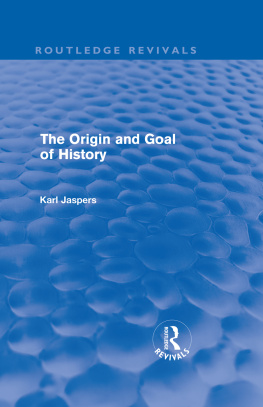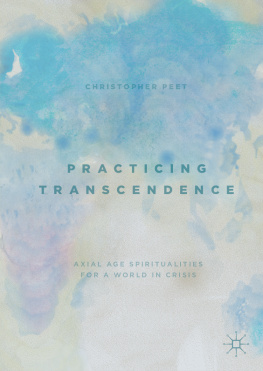FROM
WORLD RELIGIONS
TO AXIAL
CIVILIZATIONS
AND
BEYOND
SUNY series, Pangaea II: Global/Local Studies
Sad Amir Arjomand and Wolf Schfer, editors
FROM
WORLD RELIGIONS
TO AXIAL
CIVILIZATIONS
AND
BEYOND
Edited by
SAD AMIR ARJOMAND
AND
STEPHEN KALBERG
Published by State University of New York Press, Albany
2021 State University of New York
All rights reserved
Printed in the United States of America
No part of this book may be used or reproduced in any manner whatsoever without written permission. No part of this book may be stored in a retrieval system or transmitted in any form or by any means including electronic, electrostatic, magnetic tape, mechanical, photocopying, recording, or otherwise without the prior permission in writing of the publisher.
For information, contact State University of New York Press, Albany, NY
www.sunypress.edu
Library of Congress Cataloging-in-Publication Data
Names: Arjomand, Said Amir, editor. | Kalberg, Stephen, editor.
Title: From world religions to axial civilizations and beyond / [editors] Sad Amir Arjomand, Stephen Kalberg.
Description: Albany : State University of New York Press, [2021] | Series: SUNY series, Pangaea II: global/local studies | Includes bibliographical references and index.
Identifiers: LCCN 2020050107 (print) | LCCN 2020050108 (ebook) | ISBN 9781438483399 (hardcover : alk. paper) | ISBN 9781438483412 (ebook)
Subjects: LCSH: Religion and civilization. | CivilizationPhilosophy.
Classification: LCC BL55 .F75 2021 (print) | LCC BL55 (ebook) | DDC 200dc23
LC record available at https://lccn.loc.gov/2020050107
LC ebook record available at https://lccn.loc.gov/2020050108
10 9 8 7 6 5 4 3 2 1
Contents
Sad Amir Arjomand and Stephen Kalberg
Bjrn Wittrock
Stephen Kalberg
Victor Lidz
Roberto Motta
Donald A. Nielsen
Sad Amir Arjomand
Armando Salvatore
Yulia Prozorova
Eugene Halton
Sad Amir Arjomand
About Pangaea II: Global /Local Studies
This book series of the Stony Brook Institute for Global Studies engages the global challenges confronting humankind with research, analysis, and education. It aims at empowering individuals and communities to enjoy the benefits and avoid the dangers of globalization. Without political partisanship, the Stony Brook Institute for Global Studies will form worldwide partnerships with those who appreciate the vital contribution of academic excellence to achieving these aims. In so doing, it should also contribute to the extension of human rights, security, freedom, and democracy in accord with the diversity of values and cultures throughout the world.
A civilizational project of the global age, Pangaea II is emerging on the scattered geobody that our world maps depict. Pushed forward by globalization and technoscience, Pangaea II is eclipsing the configurations of nature. For the ubiquitous images, sounds, and texts of Pangaea II, earths current fragmentation into regions, cultures, continents, and islands has vanished. Rapidly branching communication and transportation networks are interweaving widely distributed societies. TV, telephony, and e-mail have escaped from the gravity of the geobody. Pangaea II is pulling the planet together and colonizing near-earth space. Vanquishing the geographic difference between halfway down the corridor and halfway around the globe, Pangaea II is a dense global conglomeration with physical and metaphysical features such as the routers of the internet and the fallacious belief that global communication should be easy because it has become instant.
Pangaea II: Global/Local Studies is committed to interdisciplinary social science and the integration of fact and theory in a global context. As the hegemony of the Western center of the world system wanes, and with it that of metropolitan social theory, pluralistic approaches to research grow and multiple centers of learning around the globe emerge. We believe in opening the social sciences, removing old disciplinary boundaries, and exploring the intricate dialectic of the global and the local in the production of knowledge. This series embraces the epistemic challenge of the global age; it privileges comparative and interdisciplinary approaches to illuminate the simultaneous local generalization of the global and the global constitution of the local. Understanding this dialectic at the core of globalization and globality is the goal of Pangaea II. Accordingly, the global/local studies published under Pangaea II combine comparative, universal theorizing with various approaches to local knowledge on national and regional topics.
Sad Amir Arjomand and Wolf Schfer
Introduction
From World Religions to Axial Civilizations and Beyond
S AD A MIR A RJOMAND AND S TEPHEN K ALBERG
The founding fathers of sociology in its classical period, mile Durkheim (d. 1917) and Max Weber (d. 1920), have been long proclaimed as theorists of modernization. In truth, however, both abjured a general theory of modern society and were committed to an empirically grounded, comparative-historical sociology as the key toward an explanation of Western modernity. Durkheim (1982[1895], 139) went so far as to declare: Comparative sociology is not a particular branch of sociology; it is sociology itself! He further demonstrated his commitment to comparative sociology in a note on civilizations co-authored with his nephew, Marcel Mauss; here, he developed a concept of civilizations in the plural (Durkheim and Mauss 1971[1913]). Durkheims students in France showed little interest in modern society and instead produced a remarkable set of studies of the Indian and Chinese, as well as ancient Greek and Egyptian, civilizations (Arjomand 2010).
There can be no doubt that Max Weber sought after 1910 or 1911 to understand why the West was the earliest civilization to develop modern capitalism and the rationalization of this-worldly conduct systematically. He sought to do so through a series of highly comparative sociological analyses that placed the world religions at the forefront. Major civilizations, he believed, usually developed in reference to them. Interestingly, Weber never used the term civilization (as did his brother Alfred). Instead, he viewed regions as civilizational zones ( Kulturkreisen or Kulturwelten ), most of which had been strongly influenced by a world religion.
Some four decades later, Webers younger colleague and friend Karl Jaspers (d. 1969) shifted Webers pivotal focus on salvation on the one hand and the connection between world religions and sociocultural transformations on the other hand to the nature of the transcendent realm. In doing so, he broadened Webers civilizational scope to include Greek philosophy. Jaspers then located the radical Greek anthropocentric breakthrough in relation to the theocentric breakthrough of Hebrew prophecy and to major value configurations in Asian religions (Hinduism, Buddhism, and Confucianism). He stressed that these breakthroughs occurred in roughly the same historical periodnamely, in the mid-first millennium before the Common Era. He called this epoch the Axial Age.
Durkheimians are rare in the second generation of comparative sociologists. Nonetheless, there are notable exceptions, such as Louis Dumont, who published Homo Hierarchicus in 1967, and Joseph Chelhod, whose work in the sociology of Islam is discussed in . The Durkheimian mode of studying non-Western societies moved to Britain and mainly assumed the form of Radcliffe-Browns generaland noncomparativetheory: structural functionalism. Eisenstadt opposed this schools tradition-modernity dichotomy sharply and introduced a multiple modernities approach. This depiction of modernity emphasized its divergent paths and its formation from the dynamics ofwhat he eventually would callaxial civilizations (Arjomand 2010).










